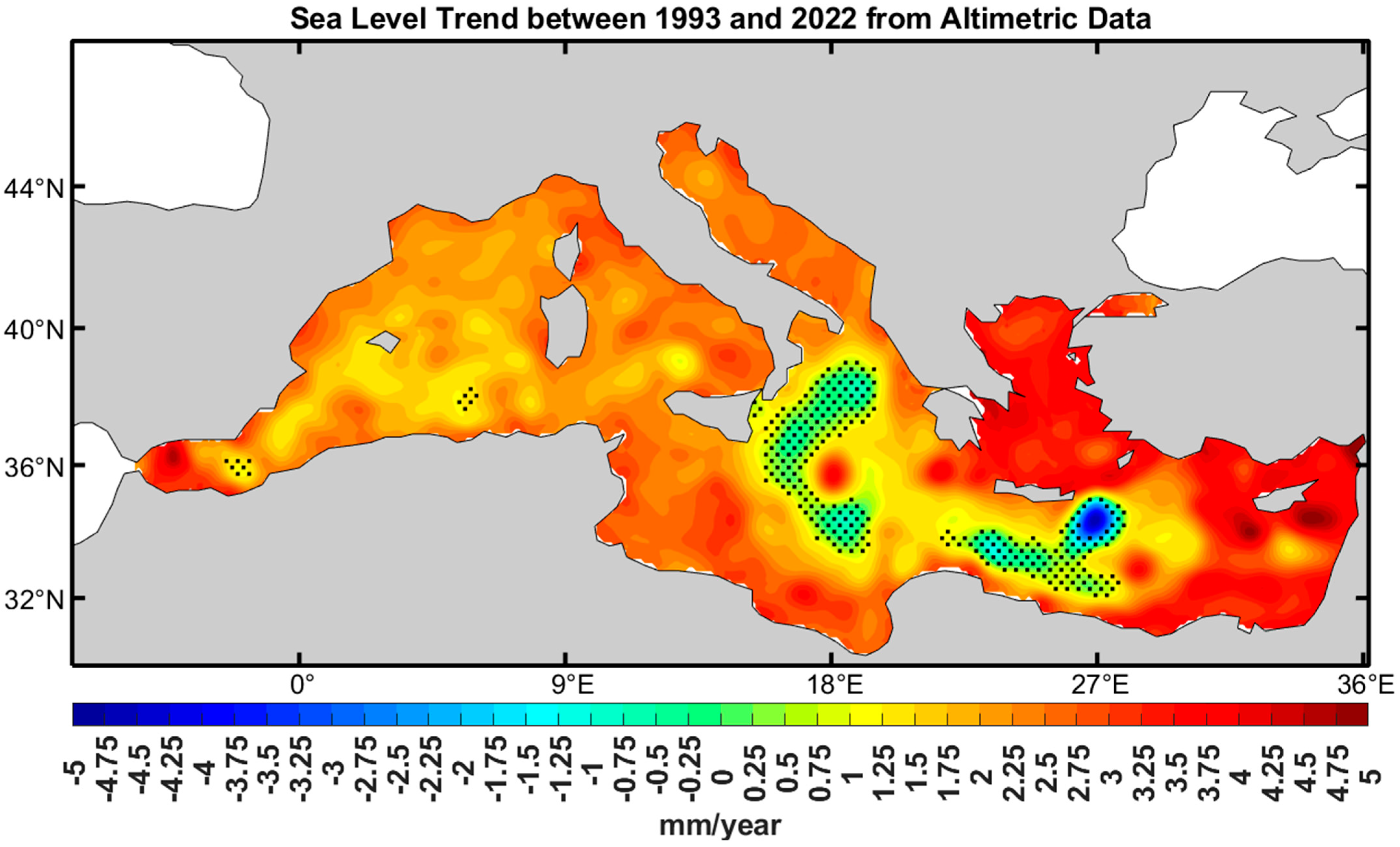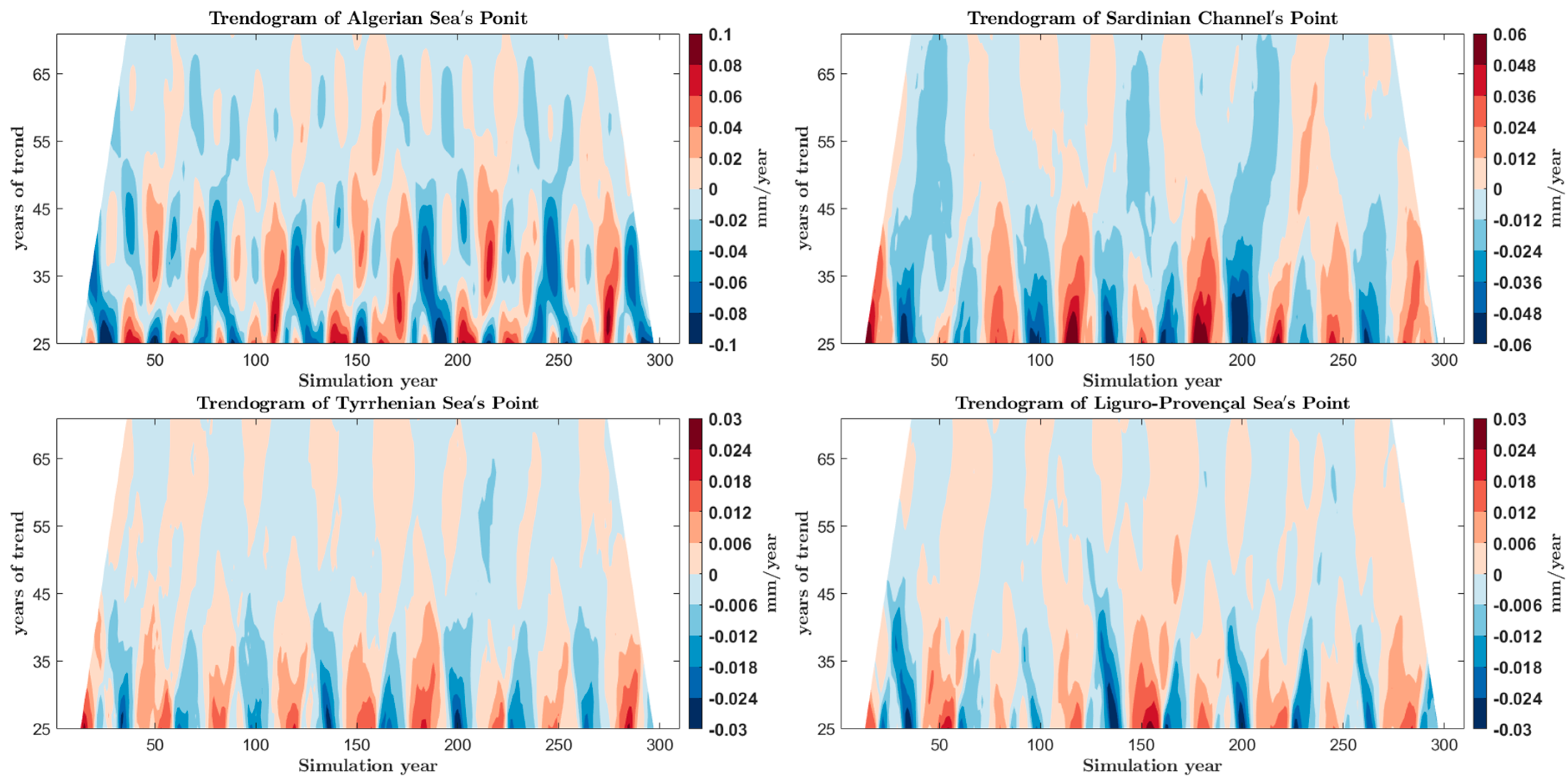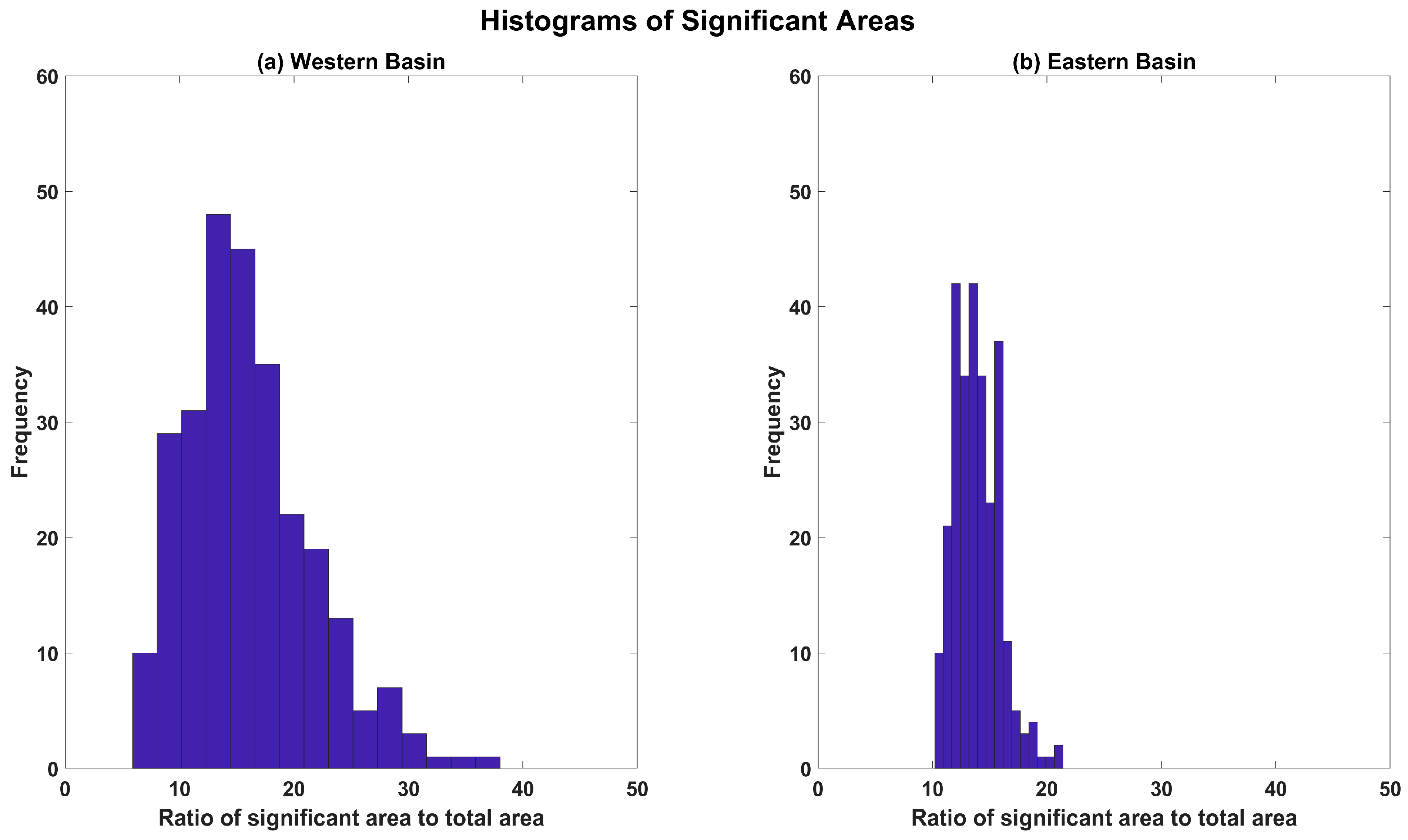Influence of Intrinsic Oceanic Variability Induced by a Steady Flow on the Mediterranean Sea Level Variability
Abstract
1. Introduction
2. Materials and Methods
2.1. Numerical Model
2.2. Observational and Simulated Data Analysis
3. Trend Analysis in Observed and Simulated Data
4. Discussion and Conclusions
Supplementary Materials
Author Contributions
Funding
Informed Consent Statement
Data Availability Statement
Acknowledgments
Conflicts of Interest
References
- Dangendorf, S.; Hay, C.; Calafat, F.M.; Marcos, M.; Piecuch, C.G.; Berk, K.; Jensen, J. Persistent acceleration in global sea-level rise since the 1960s. Nat. Clim. Change 2019, 9, 705–710. [Google Scholar] [CrossRef]
- Chaumillon, E.; Bertin, X.; Fortunato, A.B.; Bajo, M.; Schneider, J.-L.; Dezileau, L.; Walsh, J.P.; Michelot, A.; Chauveau, E.; Créach, A.; et al. Storm-induced marine flooding: Lessons from a multidisciplinary approach. Earth-Sci. Rev. 2017, 165, 151–184. [Google Scholar] [CrossRef]
- Zanchettin, D.; Bruni, S.; Raicich, F.; Lionello, P.; Adloff, F.; Androsov, A.; Antonioli, F.; Artale, V.; Carminati, E.; Ferrarin, C.; et al. Sea-level rise in Venice: Historic and future trends (review article). Nat. Hazards Earth Syst. Sci. 2021, 21, 2643–2678. [Google Scholar] [CrossRef]
- Fox-Kemper, B.; Hewitt, H.T.; Xiao, C.; Aðalgeirsdóttir, G.; Drijfhout, S.S.; Edwards, T.L.; Golledge, N.R.; Hemer, M.; Kopp, R.E.; Krinner, G.; et al. 2021: Ocean, Cryosphere and Sea Level Change. In Climate Change 2021: The Physical Science Basis. Contribution of Working Group I to the Sixth Assessment Report of the Intergovernmental Panel on Climate Change; Masson-Delmotte, V., Zhai, P., Pirani, A., Connors, S.L., Péan, C., Berger, S., Caud, N., Chen, Y., Goldfarb, L., Gomis, M.I., et al., Eds.; Cambridge University Press: Cambridge, UK; New York, NY, USA, 2021; pp. 1211–1362. [Google Scholar] [CrossRef]
- Wunsch, C.; Ponte, R.M.; Heimbach, P. Decadal trends in sea level patterns: 1993–2004. J. Clim. 2007, 20, 5889–5911. [Google Scholar] [CrossRef]
- Johnson, R.G. Climate control required a dam at the Strait of Gibraltar. Eos Trans. Am. Geophys. Union 1997, 78, 277–281. [Google Scholar] [CrossRef]
- Chan, W.-L.; Motoi, T. Effects of stopping the Mediterranean Outflow on the southern polar region. Polar Meteorol. Glaciol. 2003, 17, 25–35. [Google Scholar]
- Lozier, M.S.; Stewart, N.M. On the Temporally Varying Northward Penetration of Mediterranean Overflow Water and Eastward Penetration of Labrador Sea Water. J. Phys. Oceanogr. 2008, 38, 2097–2103. [Google Scholar] [CrossRef]
- Ivanovic, R.F.; Valdes, P.J.; Gregoire, L.; Flecker, R.; Gutjahr, M. Sensitivity of modern climate to the presence, strength and salinity of Mediterranean-Atlantic exchange in a global general circulation model. Clim. Dyn. 2014, 42, 859–877. [Google Scholar] [CrossRef]
- Ayache, M.; Swingedouw, D.; Colin, C.; Dutay, J.-C. Evaluating the impact of Mediterranean overflow on the large-scale Atlantic Ocean circulation using neodymium isotopic composition. Palaeogeogr. Palaeoclimatol. Palaeoecol. 2021, 570, 110359. [Google Scholar] [CrossRef]
- Bethoux, J.; Gentili, B.; Morin, P.; Nicolas, E.; Pierre, C.; Ruiz-Pino, D. The Mediterranean Sea: A miniature ocean for climatic and environmental studies and a key for the climatic functioning of the North Atlantic. Prog. Oceanogr. 1999, 44, 131–146. [Google Scholar] [CrossRef]
- Malanotte-Rizzoli, P.; Artale, V.; Borzelli-Eusebi, G.L.; Brenner, S.; Crise, A.; Gacic, M.; Kress, N.; Marullo, S.; Ribera d’Alcala, M.; Sofianos, S.; et al. Physical forcing and physical/biochemical variability of the Mediterranean Sea: A review of unresolved issues and directions for future research. Ocean Sci. 2014, 10, 281–322. [Google Scholar] [CrossRef]
- Rubino, A.; Gačić, M.; Bensi, M.; Kovačević, V.; Malačič, V.; Menna, M.; Negretti, M.E.; Sommeria, J.; Zanchettin, D.; Barreto, R.V.; et al. Experimental evidence of long-term oceanic circulation reversals without wind influence in the North Ionian Sea. Sci. Rep. 2020, 10, 1905. [Google Scholar] [CrossRef] [PubMed]
- Pinardi, N.; Bonaduce, A.; Navarra, A.; Dobricic, S.; Oddo, P. The mean sea level equation and its application to the mediterranean sea. J. Clim. 2014, 27, 442–447. [Google Scholar] [CrossRef]
- Spada, G.; Melini, D. On some properties of the glacial isostatic adjustment fingerprints. Water 2019, 11, 1844. [Google Scholar] [CrossRef]
- Calafat, F.M.; Frederikse, T.; Horsburgh, K. The Sources of Sea-Level Changes in the Mediterranean Sea Since 1960. J. Geophys. Res. Oceans 2022, 127, e2022JC019061. [Google Scholar] [CrossRef]
- Vera JD, R.; Criado-Aldeanueva, F.; García-Lafuente, J.; Soto-Navarro, F.J. A new insight on the decreasing sea level trend over the Ionian basin in the last decades. Glob. Planet. Change 2009, 68, 232–235. [Google Scholar] [CrossRef]
- Vigo, M.I.; Sánchez-Reales, J.M.; Trottini, M.; Chao, B.F. Mediterranean Sea level variations: Analysis of the satellite altimetric data, 1992–2008. J. Geodyn. 2011, 52, 271–278. [Google Scholar] [CrossRef]
- Calafat, F.M.; Chambers, D.P.; Tsimplis, M.N. Mechanisms of decadal sea level variability in the eastern North Atlantic and the Mediterranean Sea. J. Geophys. Res. Oceans 2012, 117, C09022. [Google Scholar] [CrossRef]
- Landerer, F.W.; Volkov, D.L. The anatomy of recent large sea level fluctuations in the Mediterranean Sea. Geophys. Res. Lett. 2013, 40, 553–557. [Google Scholar] [CrossRef]
- Tsimplis, M.N.; Calafat, F.M.; Marcos, M.; Jordà, G.; Gomis, D.; Fenoglio-Marc, L.; Struglia, M.V.; Josey, S.A.; Chambers, D. The effect of the NAO on sea level and on mass changes in the Mediterranean Sea. J. Geophys. Res. Oceans 2013, 118, 944–952. [Google Scholar] [CrossRef]
- Menna, M.; Gačić, M.; Martellucci, R.; Notarstefano, G.; Fedele, G.; Mauri, E.; Gerin, R.; Poulain, P.-M. Climatic, Decadal, and Interannual Variability in the Upper Layer of the Mediterranean Sea Using Remotely Sensed and In-Situ Data. Remote Sens. 2022, 14, 1322. [Google Scholar] [CrossRef]
- Rubino, A.; Pierini, S.; Rubinetti, S.; Gnesotto, M.; Zanchettin, D. The Skeleton of the Mediterranean Sea. J. Mar. Sci. Eng. 2023, 11, 2098. [Google Scholar] [CrossRef]
- Meli, M.; Camargo CM, L.; Olivieri, M.; Slangen AB, A.; Romagnoli, C. Sea-level trend variability in the Mediterranean during the 1993–2019 period. Front. Mar. Sci. 2023, 10, 1150488. [Google Scholar] [CrossRef]
- Gačić, M.; Ursella, L.; Kovačević, V.; Menna, M.; Malačič, V.; Bensi, M.; Negretti, M.-E.; Cardin, V.; Orlić, M.; Sommeria, J.; et al. Impact of dense-water flow over a sloping bottom on open-sea circulation: Laboratory experiments and an Ionian Sea (Mediterranean) example. Ocean Sci. 2021, 17, 975–996. [Google Scholar] [CrossRef]
- Greatbatch, R.J. A note on the representation of steric sea level in models that conserve volume rather than mass. J. Geophys. Res. Oceans 1994, 99, 12767–12771. [Google Scholar] [CrossRef]
- Pierini, S.; Rubino, A. Modeling the Oceanic Circulation in the Area of the Strait of Sicily: The Remotely Forced Dynamics. J. Phys. Oceanogr. 2001, 31, 1397–1412. [Google Scholar] [CrossRef]
- Rubino, A.; Romanenkov, D.; Zanchettin, D.; Cardin, V.; Hainbucher, D.; Bensi, M.; Boldrin, A.; Langone, L.; Miserocchi, S.; Turchetto, M. On the descent of dense water on a complex canyon system in the southern Adriatic basin. Cont. Shelf Res. 2012, 44, 20–29. [Google Scholar] [CrossRef]
- Soto-Navarro, J.; Criado-Aldeanueva, F.; García-Lafuente, J.; Sánchez-Román, A. Estimation of the Atlantic inflow through the Strait of Gibraltar from climatological and in situ data. J. Geophys. Res. Oceans 2010, 115, C10023. [Google Scholar] [CrossRef]
- García-García, D.; Vigo, M.I.; Trottini, M.; Vargas-Alemañy, J.A.; Sayol, J.-M. Hydrological cycle of the Mediterranean-Black Sea system. Clim. Dyn. 2022, 59, 1919–1938. [Google Scholar] [CrossRef]
- Sánchez-Román, A.; García-Lafuente, J.; Delgado, J.; Sánchez-Garrido, J.C.; Naranjo, C. Spatial and temporal variability of tidal flow in the Strait of Gibraltar. J. Mar. Syst. 2012, 98–99, 9–17. [Google Scholar] [CrossRef]
- NOAA National Centers for Environmental Information. 2022: ETOPO 2022 15 Arc-Second Global Relief Model; NOAA National Centers for Environmental Information: Asheville, NC, USA, 2022. [Google Scholar] [CrossRef]
- Chen, Y.; Straub, D.; Nadeau, L.-P. Interaction of Nonlinear Ekman Pumping, Near-Inertial Oscillations, and Geostrophic Turbulence in an Idealized Coupled Model. J. Phys. Oceanogr. 2021, 51, 975–987. [Google Scholar] [CrossRef]
- Marine Data Store. European Seas Gridded L 4 Sea Surface Heights and Derived Variables Reprocessed 1993 Ongoing. Available online: https://data.marine.copernicus.eu/product/SEALEVEL_EUR_PHY_L4_MY_008_068/description (accessed on 25 March 2024).
- Legeais, J.-F.; Meyssignac, B.; Faugère, Y.; Guerou, A.; Ablain, M.; Pujol, M.-I.; Dufau, C.; Dibarboure, G. Copernicus Sea Level Space Observations: A Basis for Assessing Mitigation and Developing Adaptation Strategies to Sea Level Rise. Front. Mar. Sci. 2021, 8, 704721. [Google Scholar] [CrossRef]
- Taburet, G.; Sanchez-Roman, A.; Ballarotta, M.; Pujol, M.-I.; Legeais, J.-F.; Fournier, F.; Faugere, Y.; Dibarboure, G. DUACS DT2018: 25 years of reprocessed sea level altimetry products. Ocean Sci. 2019, 15, 1207–1224. [Google Scholar] [CrossRef]
- Peltier, W.R.; Argus, D.F.; Drummond, R. Space geodesy constrains ice age terminal deglaciation: The global ICE-6G_C (VM5a) model. J. Geophys. Res. Solid Earth 2015, 120, 450–487. [Google Scholar] [CrossRef]
- Tsimplis, M.N.; Álvarez-Fanjul, E.; Gomis, D.; Fenoglio-Marc, L.; Pérez, B. Mediterranean Sea level trends: Atmospheric pressure and wind contribution. Geophys. Res. Lett. 2005, 32, L20602. [Google Scholar] [CrossRef]
- Gačić, M.; Borzelli GL, E.; Civitarese, G.; Cardin, V.; Yari, S. Can internal processes sustain reversals of the ocean upper circulation? The Ionian Sea example. Geophys. Res. Lett. 2010, 37, L09608. [Google Scholar] [CrossRef]
- Brandt, P.; Rubino, A.; Quadfasel, D.; Alpers, W.; Sellschop, J.; Fiekas, H.-V. Evidence for the Influence of Atlantic–Ionian Stream Fluctuations on the Tidally Induced Internal Dynamics in the Strait of Messina. J. Phys. Oceanogr. 1999, 29, 1071–1080. [Google Scholar] [CrossRef]
- Rubino, A.; Zanchettin, D.; Androsov, A.; Voltzinger, N.E. Tidal Records as Liquid Climate Archives for Large-Scale Interior Mediterranean Variability. Sci. Rep. 2018, 8, 12586. [Google Scholar] [CrossRef]
- Van Brummelen, G. Heavenly Mathematics: The Forgotten Art of Spherical Trigonometry; Princeton University Press: Princeton, NJ, USA, 2012. [Google Scholar]
- Gnevyshev, V.G.; Frolova, A.V.; Kubryakov, A.A.; Sobko Yu, V.; Belonenko, T.V. Interaction between Rossby Waves and a Jet Flow: Basic Equations and Verification for the Antarctic Circumpolar Current. Izv. Atmos. Ocean. Phys. 2019, 55, 412–422. [Google Scholar] [CrossRef]
- Deser, C.; Blackmon, M.L. Surface Climate Variations over the North Atlantic Ocean during Winter: 1900–1989. J. Clim. 1993, 6, 1743–1753. [Google Scholar] [CrossRef]
- Kushnir, Y. Interdecadal Variations in North Atlantic Sea Surface Temperature and Associated Atmospheric Conditions. J. Clim. 1994, 7, 141–157. [Google Scholar] [CrossRef]
- Hansen, D.V.; Bezdek, H.F. On the nature of decadal anomalies in North Atlantic sea surface temperature. J. Geophys. Res. Oceans 1996, 101, 8749–8758. [Google Scholar] [CrossRef]
- Reverdin, G.; Cayan, D.; Kushnir, Y. Decadal variability of hydrography in the upper northern North Atlantic in 1948–1990. J. Geophys. Res. Oceans 1997, 102, 8505–8531. [Google Scholar] [CrossRef]
- Zanchettin, D.; Rubino, A.; Jungclaus, J.H. Intermittent multidecadal-to-centennial fluctuations dominate global temperature evolution over the last millennium. Geophys. Res. Lett. 2010, 37, L14702. [Google Scholar] [CrossRef]
- Greatbatch, R.J.; Zhang, S. An Interdecadal Oscillation in an Idealized Ocean Basin Forced by Constant Heat Flux. J. Clim. 1995, 8, 81–91. [Google Scholar] [CrossRef]
- Sane, A.; Fox-Kemper, B.; Ullman, D.S.; Kincaid, C.; Rothstein, L. Consistent Predictability of the Ocean State Ocean Model Using Information Theory and Flushing Timescales. J. Geophys. Res. Oceans 2021, 126, e2020JC016875. [Google Scholar] [CrossRef]
- Brandt, P.; Rubino, A.; Sein, D.V.; Baschek, B.; Izquierdo, A.; Backhaus, J.O. Sea Level Variations in the Western Mediterranean Studied by a Numerical Tidal Model of the Strait of Gibraltar. J. Phys. Oceanogr. 2004, 34, 433–443. [Google Scholar] [CrossRef][Green Version]
- Josey, S.A.; Somot, S.; Tsimplis, M. Impacts of atmospheric modes of variability on Mediterranean Sea surface heat exchange. J. Geophys. Res. Oceans 2011, 116, C02032. [Google Scholar] [CrossRef]
- Skliris, N.; Sofianos, S.; Gkanasos, A.; Mantziafou, A.; Vervatis, V.; Axaopoulos, P.; Lascaratos, A. Decadal scale variability of sea surface temperature in the Mediterranean Sea in relation to atmospheric variability. Ocean Dyn. 2011, 62, 13–30. [Google Scholar] [CrossRef]





Disclaimer/Publisher’s Note: The statements, opinions and data contained in all publications are solely those of the individual author(s) and contributor(s) and not of MDPI and/or the editor(s). MDPI and/or the editor(s) disclaim responsibility for any injury to people or property resulting from any ideas, methods, instructions or products referred to in the content. |
© 2024 by the authors. Licensee MDPI, Basel, Switzerland. This article is an open access article distributed under the terms and conditions of the Creative Commons Attribution (CC BY) license (https://creativecommons.org/licenses/by/4.0/).
Share and Cite
Gnesotto, M.; Pierini, S.; Zanchettin, D.; Rubinetti, S.; Rubino, A. Influence of Intrinsic Oceanic Variability Induced by a Steady Flow on the Mediterranean Sea Level Variability. J. Mar. Sci. Eng. 2024, 12, 1356. https://doi.org/10.3390/jmse12081356
Gnesotto M, Pierini S, Zanchettin D, Rubinetti S, Rubino A. Influence of Intrinsic Oceanic Variability Induced by a Steady Flow on the Mediterranean Sea Level Variability. Journal of Marine Science and Engineering. 2024; 12(8):1356. https://doi.org/10.3390/jmse12081356
Chicago/Turabian StyleGnesotto, Michele, Stefano Pierini, Davide Zanchettin, Sara Rubinetti, and Angelo Rubino. 2024. "Influence of Intrinsic Oceanic Variability Induced by a Steady Flow on the Mediterranean Sea Level Variability" Journal of Marine Science and Engineering 12, no. 8: 1356. https://doi.org/10.3390/jmse12081356
APA StyleGnesotto, M., Pierini, S., Zanchettin, D., Rubinetti, S., & Rubino, A. (2024). Influence of Intrinsic Oceanic Variability Induced by a Steady Flow on the Mediterranean Sea Level Variability. Journal of Marine Science and Engineering, 12(8), 1356. https://doi.org/10.3390/jmse12081356






